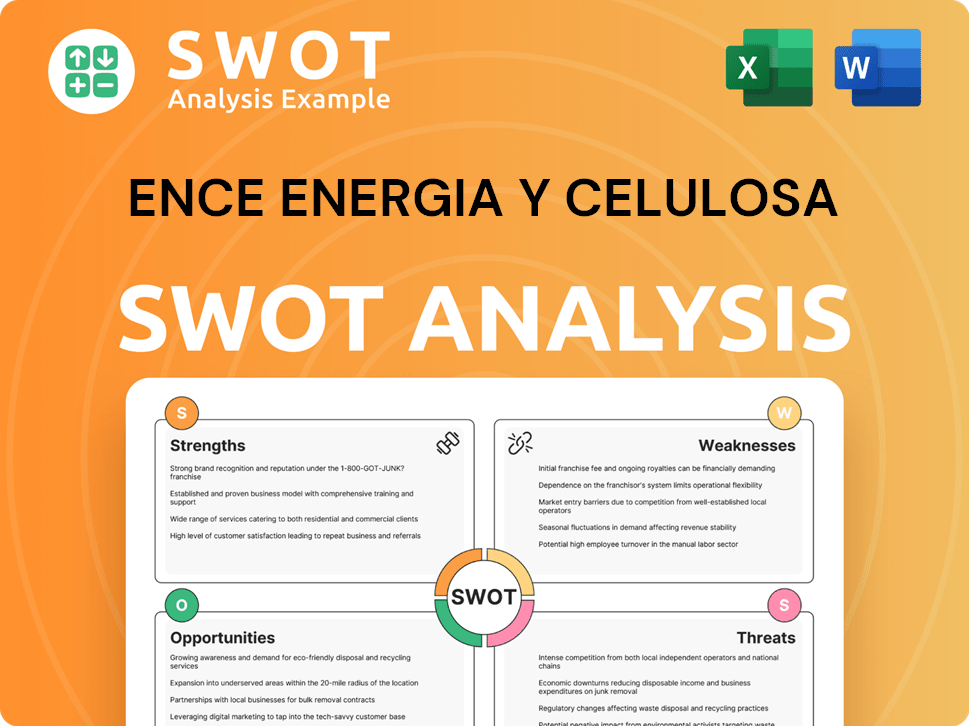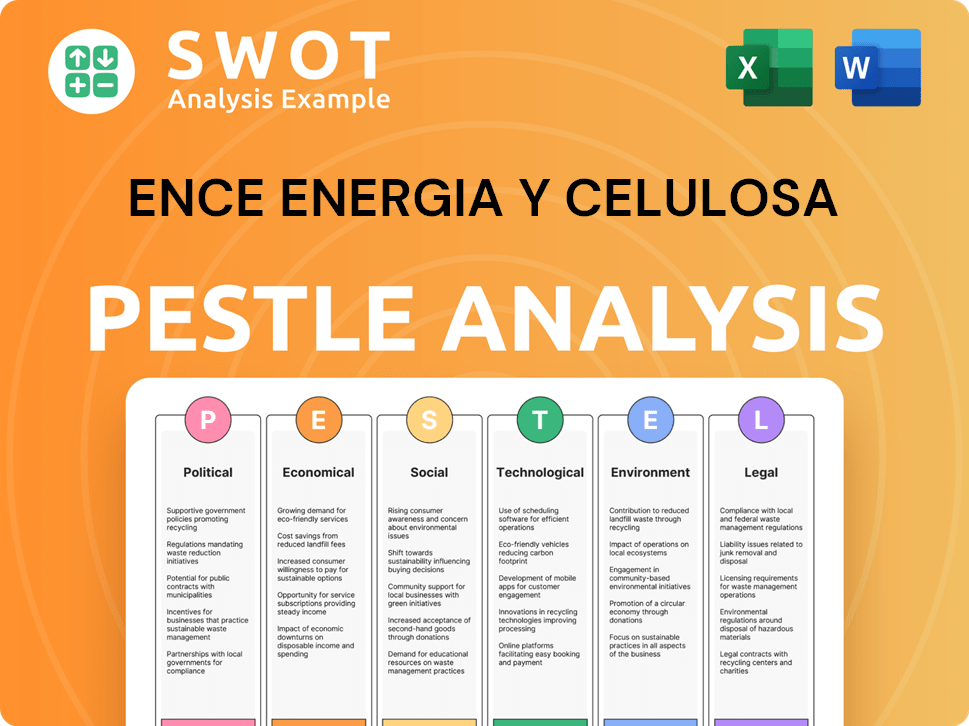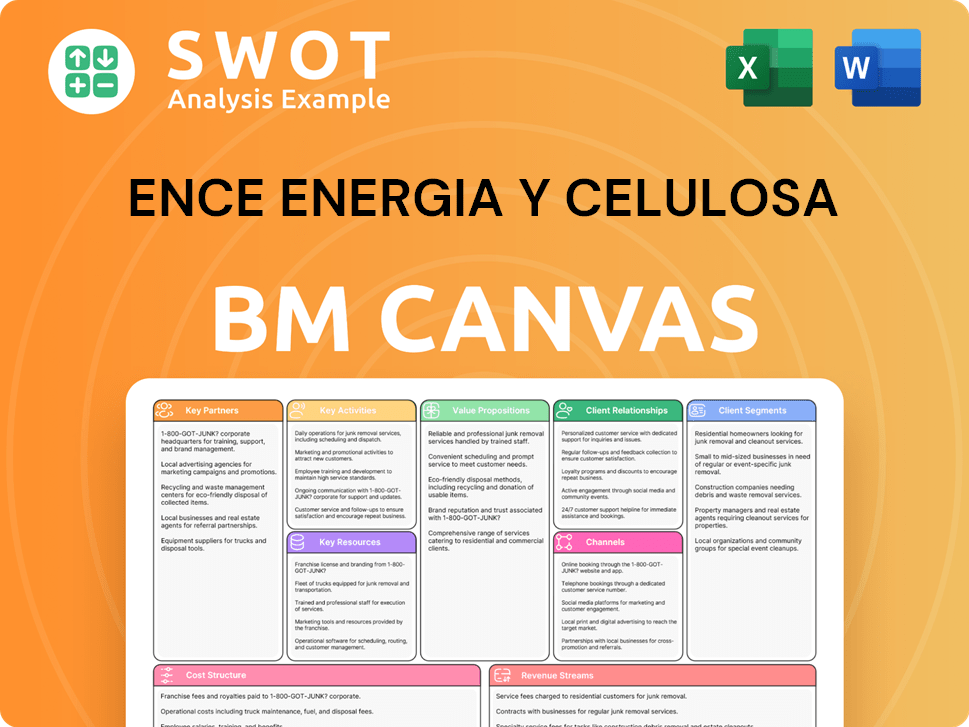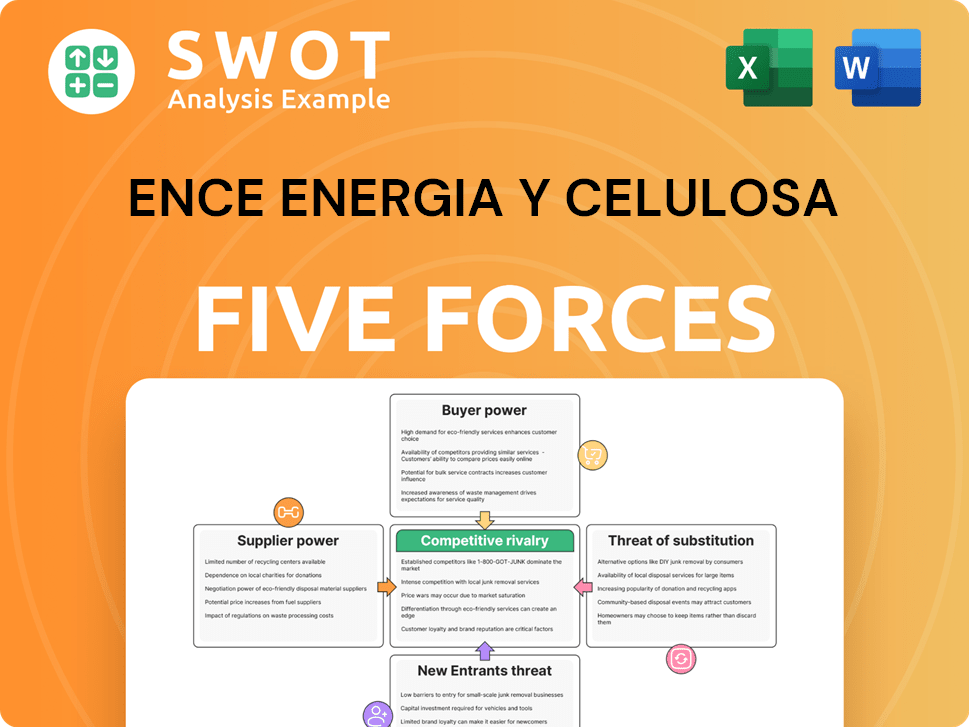Ence Energia Y Celulosa Bundle
Who Buys from Ence Energia Y Celulosa?
In today's evolving market, understanding the Ence Energia Y Celulosa SWOT Analysis is crucial for investors and strategists alike. The company's shift towards renewable energy and sustainable practices has significantly broadened its customer base. This necessitates a deep dive into customer demographics and target market dynamics to fully grasp Ence's strategic positioning and growth prospects.

This exploration delves into the Company profile of Ence, examining its evolution from pulp production to renewable energy, and how it strategically adapts to meet the needs of its diverse customer segments. We'll conduct a detailed market analysis to uncover the consumer behavior driving demand for Ence's products and services, providing actionable insights for informed decision-making. Understanding the Ence Energia Y Celulosa target audience analysis is key to evaluating its long-term sustainability and investment potential.
Who Are Ence Energia Y Celulosa’s Main Customers?
Understanding the primary customer segments of Ence Energía y Celulosa is crucial for a comprehensive Growth Strategy of Ence Energia Y Celulosa. The company operates primarily in the business-to-business (B2B) sector, with its customer base divided between its pulp production and renewable energy generation divisions. This focus shapes its approach to market analysis and customer engagement.
For the pulp business, the target market consists of large industrial entities. These include paper and board manufacturers, tissue producers, and specialty paper companies worldwide. Key factors influencing purchasing decisions include pulp quality, supply consistency, and sustainable sourcing certifications. In the renewable energy sector, the primary customers are electricity grid operators and large industrial consumers.
The company's strategic shift reflects a response to market dynamics and a commitment to sustainability. This evolution is evident in the diversification of its customer base. The company's total renewable energy production in 2023 was 2.0 TWh, highlighting the scale of its energy operations and the importance of its energy sector clientele.
The core customer demographics for the pulp business include paper and board manufacturers, tissue producers, and specialty paper companies globally. These clients are typically large industrial entities. Their purchasing decisions are influenced by pulp quality, supply reliability, and sustainable sourcing certifications.
In the renewable energy sector, Ence's primary customer segments include electricity grid operators and large industrial consumers. These customers prioritize reliable energy supply, compliance with renewable energy mandates, and competitive energy pricing. The fastest-growing segment is within the renewable energy division.
The decision-makers in these organizations are typically experienced professionals. They often have backgrounds in procurement, operations, or R&D. These individuals often possess expertise in engineering, chemistry, or business. The company's approach is tailored to meet the specific needs of these professionals.
Ence has seen a significant shift in its target segments over time. This shift was prompted by strategic diversification initiatives. Market research indicated strong growth in renewable energy. External trends favoring sustainable energy sources also played a role in this shift.
Understanding the customer's needs is crucial for Ence. The company must focus on specific customer segments. The buying habits of Ence's customers are influenced by various factors.
- Pulp quality and consistency for paper manufacturers.
- Reliable and competitively priced renewable energy for grid operators.
- Compliance with sustainability standards, such as FSC or PEFC certifications.
- The company's marketing strategies are tailored to reach its target audience effectively.
Ence Energia Y Celulosa SWOT Analysis
- Complete SWOT Breakdown
- Fully Customizable
- Editable in Excel & Word
- Professional Formatting
- Investor-Ready Format

What Do Ence Energia Y Celulosa’s Customers Want?
Understanding the customer needs and preferences is crucial for the success of any company. This is particularly true for a company like Ence Energia Y Celulosa, which operates in two distinct segments: pulp and renewable energy. The company's ability to meet these diverse needs directly impacts its market position and profitability. A detailed analysis of customer demographics and preferences is essential for effective strategic planning.
The needs of Ence Energia Y Celulosa's customers vary significantly between its pulp and energy divisions. While the pulp segment focuses on quality and sustainability, the energy segment prioritizes reliability and cost-effectiveness. Both segments, however, share a common demand for dependable supply and environmentally responsible practices. This dual focus necessitates a tailored approach to customer relationship management and product development.
To understand the company's customer base, a thorough market analysis is necessary. This includes examining the specific needs and preferences of each customer segment, their buying behaviors, and the factors that influence their purchasing decisions. By aligning its operations with these customer demands, Ence Energia Y Celulosa can enhance its competitive advantage and ensure long-term sustainability. For more insights into the company's structure, you can read about the Owners & Shareholders of Ence Energia Y Celulosa.
Pulp customers prioritize consistent, high-quality eucalyptus pulp. They require specific technical specifications for their paper and board products. Sustainability certifications, like FSC and PEFC, are increasingly important.
Renewable energy customers, including grid operators, seek reliable electricity from biomass. They focus on the stability of supply, grid integration, and competitive pricing. Compliance with renewable energy targets is a key driver.
Both customer groups value reliability and sustainability. Pulp customers need high-quality pulp and sustainable sourcing. Energy customers need a stable, renewable energy source.
Pulp customers often base decisions on technical evaluations and long-term contracts. Energy customers consider supply stability and compliance. Both prioritize cost-effectiveness.
Ence maintains stringent quality control and sustainable forest management. It ensures robust logistics for pulp and leverages biomass expertise for energy. The company invests in operational efficiency and technological improvements.
Customer feedback has influenced Ence's focus on operational efficiency and sustainability. Investments in optimizing pulp production and biomass plant efficiency directly address customer demands.
Ence Energia Y Celulosa's target market can be segmented based on product type and customer needs. Pulp customers require high-quality, sustainable pulp, while energy customers need reliable renewable energy. Understanding these segments is crucial for effective marketing and product development.
- Pulp Customers: Paper mills, packaging companies, and other manufacturers requiring eucalyptus pulp.
- Energy Customers: Grid operators, industrial consumers, and utilities seeking renewable energy sources.
- Key Needs: Quality, reliability, sustainability, competitive pricing, and compliance with environmental regulations.
- Buying Habits: Long-term contracts, technical specifications, price negotiations, and adherence to sustainability standards.
Ence Energia Y Celulosa PESTLE Analysis
- Covers All 6 PESTLE Categories
- No Research Needed – Save Hours of Work
- Built by Experts, Trusted by Consultants
- Instant Download, Ready to Use
- 100% Editable, Fully Customizable

Where does Ence Energia Y Celulosa operate?
The geographical market presence of Ence Energía y Celulosa is primarily focused on Europe, with a strong emphasis on Spain. Spain serves as the central hub for its operations, housing its pulp mills and biomass energy plants. This strategic positioning allows the company to utilize local forest resources and contribute to the Spanish energy grid.
Within Spain, Ence holds a significant market share in eucalyptus pulp production and plays a crucial role in renewable energy generation from biomass. The company's facilities in regions like Pontevedra and Huelva are key to its operational efficiency and access to raw materials. This focus on Spain is a core element of its business strategy, influencing both its production capabilities and its market reach.
Beyond Spain, Ence exports its pulp products to various European countries, indicating a broader European market presence for its cellulosic products. The company's annual reports reveal a diverse client base across the continent, driven by the demand for high-quality eucalyptus pulp for various paper and board applications. The company's market analysis shows that customer preferences vary across these regions, often relating to specific pulp grades or delivery logistics.
Ence's operations are heavily concentrated in Spain, where it has established pulp mills and biomass energy plants. This concentration allows the company to effectively manage its resources and contribute to the local economy. This strategic focus is a key element of the company's business model.
Ence exports its pulp products to several European countries, expanding its market reach beyond Spain. The company's customer base includes various European nations, driven by the demand for high-quality eucalyptus pulp. This diversification supports its overall growth strategy.
The renewable energy segment of Ence is primarily focused on the Spanish market, with electricity generated fed into the national grid. The company's expansion strategies are focused on optimizing and expanding its existing biomass capacity within Spain. The company's commitment to renewable energy is reflected in its investments in new biomass plants.
The company's strategy involves adapting to the evolving demands of the European market. This includes tailoring pulp grades and optimizing logistics to meet specific customer needs. The company's market analysis and customer demographics help guide its strategic decisions. For a deeper dive, explore the Brief History of Ence Energia Y Celulosa.
Ence Energia Y Celulosa Business Model Canvas
- Complete 9-Block Business Model Canvas
- Effortlessly Communicate Your Business Strategy
- Investor-Ready BMC Format
- 100% Editable and Customizable
- Clear and Structured Layout

How Does Ence Energia Y Celulosa Win & Keep Customers?
The company, operating in the pulp and energy sectors, uses distinct strategies for customer acquisition and retention, reflecting its B2B business model. For pulp, building long-term relationships based on trust and consistent product quality is key. This involves direct engagement with procurement teams and showcasing sustainable certifications. In the renewable energy segment, competitive tariffs and reliable power supply are crucial for attracting and retaining customers.
Acquisition strategies in the pulp sector include direct sales to paper and board manufacturers, participation in industry events, and highlighting sustainability certifications. In the energy sector, the company focuses on direct sales to large industrial consumers looking for green energy and participation in energy auctions. Customer data and CRM systems are essential for managing client relationships and forecasting demand in both segments. The company's commitment to sustainable practices also indirectly supports customer acquisition and retention.
Retention efforts across both sectors emphasize maintaining high product standards, ensuring timely deliveries, and providing excellent technical support. Loyalty is fostered through competitive pricing, a strong reputation for sustainability, and flexible contractual agreements. The company's investments in sustainable forest management and advanced biomass energy technologies further enhance its appeal to environmentally conscious customers. To learn more about the company's strategic direction, you can explore the Growth Strategy of Ence Energia Y Celulosa.
The company's pulp division focuses on direct sales to paper and board manufacturers. Participation in industry conferences and trade shows is a key strategy. Showcasing sustainable certifications helps attract environmentally conscious clients.
In the renewable energy sector, the company targets large industrial consumers. Participation in energy auctions is another important acquisition channel. Competitive energy tariffs and reliable supply are key factors.
Retention strategies include maintaining high product standards and ensuring timely deliveries. Providing excellent technical support and building trust are also vital. Flexible contractual agreements and competitive pricing support customer loyalty.
Consistent power generation and adherence to contractual obligations are crucial for retention. Transparent communication regarding energy output and environmental impact is also emphasized. The company focuses on reliable and sustainable energy solutions.
Customer data and CRM systems play a significant role in managing client relationships. These tools help track energy consumption patterns and forecast demand. This data-driven approach supports both acquisition and retention efforts.
- Historical purchasing patterns inform personalized sales approaches.
- Technical specifications are crucial for product customization.
- Customer data aids in anticipating and meeting needs effectively.
- CRM systems enhance relationship management and service delivery.
Ence Energia Y Celulosa Porter's Five Forces Analysis
- Covers All 5 Competitive Forces in Detail
- Structured for Consultants, Students, and Founders
- 100% Editable in Microsoft Word & Excel
- Instant Digital Download – Use Immediately
- Compatible with Mac & PC – Fully Unlocked

Related Blogs
- What are Mission Vision & Core Values of Ence Energia Y Celulosa Company?
- What is Competitive Landscape of Ence Energia Y Celulosa Company?
- What is Growth Strategy and Future Prospects of Ence Energia Y Celulosa Company?
- How Does Ence Energia Y Celulosa Company Work?
- What is Sales and Marketing Strategy of Ence Energia Y Celulosa Company?
- What is Brief History of Ence Energia Y Celulosa Company?
- Who Owns Ence Energia Y Celulosa Company?
Disclaimer
All information, articles, and product details provided on this website are for general informational and educational purposes only. We do not claim any ownership over, nor do we intend to infringe upon, any trademarks, copyrights, logos, brand names, or other intellectual property mentioned or depicted on this site. Such intellectual property remains the property of its respective owners, and any references here are made solely for identification or informational purposes, without implying any affiliation, endorsement, or partnership.
We make no representations or warranties, express or implied, regarding the accuracy, completeness, or suitability of any content or products presented. Nothing on this website should be construed as legal, tax, investment, financial, medical, or other professional advice. In addition, no part of this site—including articles or product references—constitutes a solicitation, recommendation, endorsement, advertisement, or offer to buy or sell any securities, franchises, or other financial instruments, particularly in jurisdictions where such activity would be unlawful.
All content is of a general nature and may not address the specific circumstances of any individual or entity. It is not a substitute for professional advice or services. Any actions you take based on the information provided here are strictly at your own risk. You accept full responsibility for any decisions or outcomes arising from your use of this website and agree to release us from any liability in connection with your use of, or reliance upon, the content or products found herein.